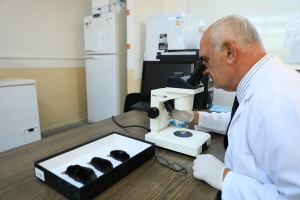Largest Mole Species Discovered in Hakkari
The new mole species and subspecies discovered in Anatolia with the study led by Ondokuz Mayıs University (OMU) academicians were introduced to the world of science.
A new species and subspecies of mole was discovered as a result of the study carried out by Prof. Dr. Islam Gündüz and his research team, and Prof. Dr. David T. Bilton from Plymouth University in England, and Prof. Dr. P. David Polly from Indiana University in the USA.
The Anatolian mole species, found on the Türkiye-Iraq border due to 6 years of teamwork and has a larger body structure than the others, was named "Talpa hakkariensis" because it was found in Hakkari. With this species, the number of Talpa mole species worldwide increased to 15.
Prof. Dr. Gündüz said that Talpa moles appeared about 6.5-7 million years ago. Stating that the moles in this genus have expanded their distribution in the Western Palearctic Region, which includes Europe, Asia, and North Africa, and that today they are distributed in Europe and Western Asia and consist of taxa, Gündüz said: "They are often morphologically very similar due to adaptation to similar living conditions. This general morphological similarity is a factor that makes it difficult to uncover some possible undiscovered species within this genus. Morphologically based studies to date suggest that there are about 13-14 valid species in this genus. However, recent studies using current DNA-based molecular techniques suggest that new hidden species may be waiting to be discovered."
"Talpa hakkariensis" is a new species endemic to Türkiye
Stating that OMU Scientific Research Projects Office supported the project, Gündüz continued as follows:
"As a result of the work we did with my teammates and colleagues from the US and the UK, we discovered a population in Hakkari, on the Iraq-Türkiye border, at an altitude of about 3,000 meters above sea level, in very narrow and specific habitats. Our detailed morphological and genetic studies suggested this could be a new species within the genus rather than a population or even a new species endemic to Turkey. We presented this species to the scientific community as 'Talpa hakkariensis', that is, the mole species identified from the Hakkari region, in reference to Hakkari, where it was first described. This study was made available online last week in the Zoological Journal of the Linnean Society, a highly respected journal in its field."
Stating that in addition to the newly discovered species, they also found a subspecies as a result of the studies, Gündüz said, "In addition to this new species, we also studied another species previously known as Talpa davidiana within this species because we are working on the revision of the genus, that is, revising it again. In our study on this species, we have revealed for the first time that the species called T. davidiana in Türkiye consists of two subspecies. In this context, we have introduced a new subspecies to the scientific world with the same study, referring to the place where the taxon 'Talpadavidiana tatvanensis' from the Bitlis Tatvan region was described."
7 of 15 mole species are seen in Türkiye
Explaining that the number of Talpa moles increased from 14 to 15 with the project, Gündüz said:
"Most importantly, 7 of these 15 species are currently distributed in Türkiye, mainly Anatolia. We think that Türkiye's different climate, geographical barriers, and topography, especially Anatolia, may be a critical factor in the biodiversification of this genus. Morphologically, this species is the largest in terms of body size described in this genus. You can see this when you go to the field; when you open their burrows, you can see the diameter of the gallery that the animals have opened under the soil. The skull is in line with the body size. It definitely has a larger skull than its sister species, considered the closest species. Most importantly, there are big differences in tooth morphology. For example, while the closely related species have three premolars, these have four premolars in parallel with the larger skull. This stands out as a completely species-specific character that defines it."
The article published in the journal about the study can be accessed at:



















